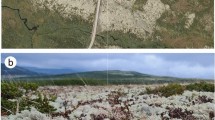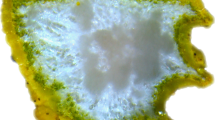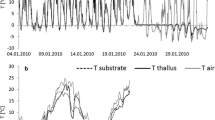Abstract
We quantified relative growth rates (RGR) in shade-adapted and melanin-deficient thalli of Cetraria islandica and Lobaria pulmonaria cultivated in short-term growth chamber experiments with and without UV-B radiation. In the first experiment done under optimal PAR (125 μmol m−2 s−1), but high UV-B radiation (1 W m−2), UV-B radiation significantly reduced RGR (P < 0.001). The second experiment with higher PAR, but more natural ratios between wavelength ranges (PAR: 500 μmol m−2 s−1; UV-A: 7 W m−2; UV-B: 0.4 W m−2), caused a reduction in mean RGR in L. pulmonaria to just 45% of rates in experiment 1. Lobaria pulmonaria screened from UV-B radiation had 1.9 and 1.6 times higher RGR than non-screened thalli in experiment 1 and 2, respectively. UV-B radiation significantly induced melanin synthesis in the second experiment only, causing significantly less photoinhibition than in thalli receiving just PAR. This is consistent with PAR-protective roles of melanins. Chlorophylls were not affected by UV-B radiation in any experiment. Because UV-B radiation affected RGR more than pure photobiont responses, the mycobiont is likely the more UV-B-susceptible partner. Apart from reduced RGR, we found little evidence for adverse UV-B effects.


Similar content being viewed by others
References
Alam MA, Gauslaa Y, Solhaug KA (2015) Soluble carbohydrates and relative growth rates in chloro-, cyano- and cephalolichens: effects of temperature and nocturnal hydration. New Phytol 208(3):750–762. doi:10.1111/nph.13484
Aphalo PJ, Albert A, Björn LO, McLeod A, Robson TM, Rosenqvist E (eds) (2012) Beyond the visible:a handbook of best practice in plant UV photobiology. COST Action FA0906 UV4growth. University of Helsinki, Division of Plant Biology, Helsinki
Armstrong RA, Bradwell T (2011) Growth of foliose lichens: a review. Symbiosis 53(1):1–16
Bidussi M, Gauslaa Y, Solhaug KA (2013a) Prolonging the hydration and active metabolism from light periods into nights substantially enhances lichen growth. Planta 237:1359–1366
Bidussi M, Goward T, Gauslaa Y (2013b) Growth and secondary compounds investments in the epiphytic lichens Lobaria pulmonaria and Hypogymnia occidentalis transplanted along an altitudinal gradient in British Columbia. Botany 91:621–630
Bjerke JW, Lerfall K, Elvebakk A (2002) Effects of ultraviolet radiation and PAR on the content of usnic and divaricatic acids in two arctic-alpine lichens. Photochem Photobiol Sci 1(9):678–685
Bjerke JW, Gwynn-Jones D, Callaghan TV (2005) Effects of enhanced UV-B radiation in the field on the concentration of phenolics and chlorophyll fluorescence in two boreal and arctic–alpine lichens. Environ Exp Bot 53(2):139–149
Brenner M, Hearing VJ (2008) The protective role of melanin against UV damage in human skin. Photochem Photobiol 84(3):539–549. doi:10.1111/j.1751-1097.2007.00226.x
Buffoni-Hall RS, Bornman JF, Björn LO (2002) UV-induced changes in pigment content and light penetration in the fruticose lichen Cladonia arbuscula ssp. mitis. JPhotochemPhotobiol, B 66(1):13–20
Buffoni Hall RS, Paulsson M, Duncan K, Tobin AK, Widell S, Bornman JF (2003) Water-and temperature-dependence of DNA damage and repair in the fruticose lichen Cladonia arbuscula ssp. mitis exposed to UV-B radiation. Physiol Plant 118(3):371–379
Burchard P, Bilger W, Weissenböck G (2000) Contribution of hydroxycinnamates and flavonoids to epidermal shielding of UV-A and UV-B radiation in developing rye primary leaves as assessed by ultraviolet-induced chlorophyll fluorescence measurements. Plant Cell Environ 23:1373–1380
Caldwell MM, Björn LO, Bornman JF, Flint SD, Kulandaivelu G, Teramura AH, Tevini M (1998) Effects of increased solar ultraviolet radiation on terrestrial ecosystems. J Photochem Photobiol B Biol 46(1):40–52
Eaton S, Ellis CJ (2014) High demographic rates of the model epiphyte Lobaria pulmonaria in an oceanic Hazelwood (western Scotland). Fungal Ecol 11:60–70. doi:10.1016/j.funeco.2014.03.007
Gauslaa Y (2006) Trade-off between reproduction and growth in the foliose old forest lichen Lobaria pulmonaria. Basic and Applied Ecology 7:455–460
Gauslaa Y, Goward T (2012) Relative growth rates of two epiphytic lichens, Lobaria pulmonaria and Hypogymnia occidentalis, transplanted within and outside of Populus dripzones. Botany 90:954–965
Gauslaa Y, McEvoy M (2005) Seasonal changes in solar radiation drive acclimation of the sun-screening compound parietin in the lichen Xanthoria parietina. Basic and Applied Ecology 6:75–82
Gauslaa Y, Solhaug KA (1996) Differences in the susceptibility to light stress between epiphytic lichens of ancient and young boreal forest stands. Funct Ecol 10:344–354
Gauslaa Y, Solhaug KA (1999) High-light damage in air-dry thalli of the old forest lichen Lobaria pulmonaria - interactions of irradiance, exposure duration and high temperature. J Exp Bot 50:697–705
Gauslaa Y, Solhaug KA (2001) Fungal melanins as a sun screen for symbiotic green algae in the lichen Lobaria pulmonaria. Oecologia 126:462–471
Gauslaa Y, Lie M, Solhaug KA, Ohlson M (2006) Growth and ecophysiological acclimation of the foliose lichen Lobaria pulmonaria in forests with contrasting light climates. Oecologia 147:406–416
Grishkan I, Nevo E (2010) Spatiotemporal distribution of soil microfungi in the Makhtesh Ramon area, central Negev desert, Israel. Fungal Ecol 3(4):326–337. doi:10.1016/j.funeco.2010.01.003
Hideg É, Jansen MAK, Strid Å (2013) UV-B exposure, ROS, and stress: inseparable companions or loosely linked associates? Trends Plant Sci 18(2):107–115. doi:10.1016/j.tplants.2012.09.003
Jenkins GI (2009) Signal transduction in responses to UV-B radiation. Annu Rev Plant Biol 60:407–431
Larsson P, Večeřová K, Cempírková H, Solhaug KA, Gauslaa Y (2009) Does UV-B influence biomass growth in lichens deficient in sun-screening pigments? Environ Exp Bot 67(1):215–221
Leppik E, Jüriado I, Suija A, Liira J (2015) Functional ecology of rare and common epigeic lichens in alvar grasslands. Fungal Ecol 13:66–76. doi:10.1016/j.funeco.2014.08.003
Li F-R, Peng S-L, Chen B-M, Hou Y-P (2010) A meta-analysis of the responses of woody and herbaceous plants to elevated ultraviolet-B radiation. Acta Oecol-Int J Ecol 36(1):1–9. doi:10.1016/j.actao.2009.09.002
Lichtenthaler H, Wellburn A (1983) Determinations of total carotenoids and chlorophylls a and b of leaf extracts in different solvent. Biochem Soc Trans 603:591–593
Lutsak T, Fernández-Mendoza F, Kirika P, Wondafrash M, Printzen C (2016) Mycobiont-photobiont interactions of the lichen Cetraria aculeata in high alpine regions of East Africa and South America. Symbiosis 68(1–3):25–37. doi:10.1007/s13199-015-0351-1
Matee LP, Beckett RP, Solhaug KA, Minibayeva FV (2016) Characterization and role of tyrosinases in the lichen Lobaria pulmonaria (L.) Hoffm. Lichenologist 48(4):311–322. doi:10.1017/s0024282916000293
McEvoy M, Nybakken L, Solhaug KA, Gauslaa Y (2006) UV triggers the synthesis of the widely distributed secondary compound usnic acid. Mycol Prog 5:221–229
McEvoy M, Solhaug KA, Gauslaa Y (2007) Solar radiation screening in usnic acid-containing cortices of the lichen Nephroma arcticum. Symbiosis 43:143–150
Meeßen J, Sánchez F, Sadowsky A, de la Torre R, Ott S, de Vera J-P (2013) Extremotolerance and resistance of lichens: comparative studies on five species used in astrobiological research II. Secondary lichen compounds. Orig Life Evol Biosph 43(6):501–526
Merinero S, Martínez I, Rubio-Salcedo M, Gauslaa Y (2015) Proximity to the ground boosts epiphytic lichen growth in Mediterranean forests. Basic Appl Ecol 55:59–64
Nybakken L, Julkunen-Tiitto R (2006) UV-B induces usnic acid in reindeer lichens. Lichenologist 38:477–485
Nybakken L, Solhaug KA, Bilger W, Gauslaa Y (2004) The lichens Xanthoria elegans and Cetraria islandica maintain a high protection against UV-B radiation in Arctic habitats. Oecologia 140:211–216
Palmqvist K, Sundberg B (2002) Characterising photosynthesis and respiration in freshly isolated or cultured lichen photobionts. In: Protocols in Lichenology. Springer, pp 152–181
Riley P (1997) Melanin. Int J Biochem Cell Biol 29(11):1235–1239
Robson TM, Klem K, Urban O, Jansen MAK (2015) Re-interpreting plant morphological responses to UV-B radiation. Plant Cell Environ 38(5):856–866. doi:10.1111/pce.12374
Routaboul C, Denis A, Vinche A (1999) Immediate pigment darkening: description, kinetic and biological function. Eur J Dermatol 9(2):95–99
Rozema J, Björn LO, Bornman JF, Gaberscik A, Häder DP, Trost T, Germ M, Klisch M, Gröniger A, Sinha RP, Lebert M, He YY, Buffoni-Hall R, de Bakker NVJ, van de Staaij J, Meijkamp BB (2002) The role of UV-B radiation in aquatic and terrestrial ecosystems - an experimental and functional analysis of the evolution of UV-absorbing compounds. J Photochem Photobiol B 66(1):2–12
Searles PS, Flint SD, Caldwell MM (2001) A meta-analysis of plant field studies simulating stratospheric ozone depletion. Oecologia 127:1–10
Solhaug KA, Gauslaa Y (1996) Parietin, a photoprotective secondary product of the lichen Xanthoria parietina. Oecologia 108(3):412–418
Solhaug KA, Gauslaa Y (2004) Photosynthates stimulate the UV-B induced fungal anthraquinone synthesis in the foliose lichen Xanthoria parietina. Plant Cell Environ 27:167–176
Solhaug KA, Gauslaa Y (2012) Secondary lichen compounds as protection against excess solar radiation and herbivores. In: Progress in Botany 73. Springer, pp 283–304
Solhaug KA, Gauslaa Y, Nybakken L, Bilger W (2003) UV-induction of sun-screening pigments in lichens. New Phytol 158:91–100
Solhaug KA, Larsson P, Gauslaa Y (2010) Light screening in lichen cortices can be quantified by chlorophyll fluorescence techniques for both reflecting and absorbing pigments. Planta 231:1003–1011
Sonesson M, Callaghan T, Björn LO (1995) Short-term effects of enhanced UV-B and CO 2 on lichens at different latitudes. Lichenologist 27(06):547–557
Wellburn AR (1994) The spectral determination of chlorophylls a and b, as well as total carotenoids, using various solvents with spectrophotometers of different resolution. J Plant Physiol 144(3):307–313
Acknowledgements
The Research Council of Norway, South Africa – Norway, Research co-operation (SANCOOP), project 234178, is thanked for financial support. We also thank two anonymous reviewers for useful comments.
Author information
Authors and Affiliations
Corresponding author
Rights and permissions
About this article
Cite this article
Chowdhury, D.P., Solhaug, K.A. & Gauslaa, Y. Ultraviolet radiation reduces lichen growth rates. Symbiosis 73, 27–34 (2017). https://doi.org/10.1007/s13199-016-0468-x
Received:
Accepted:
Published:
Issue Date:
DOI: https://doi.org/10.1007/s13199-016-0468-x




